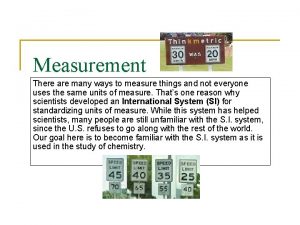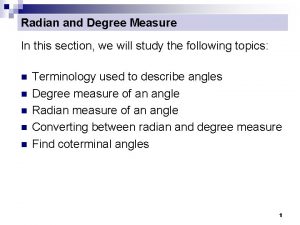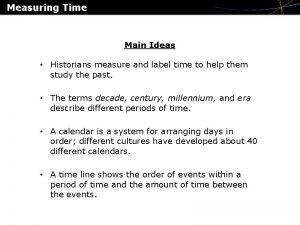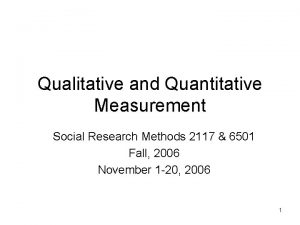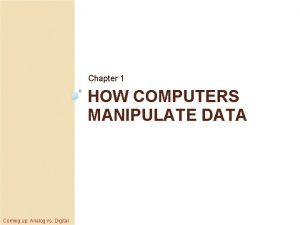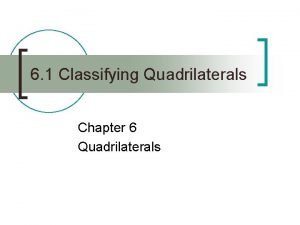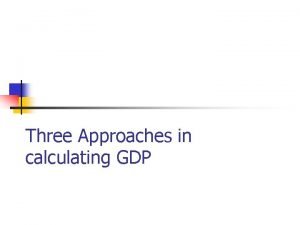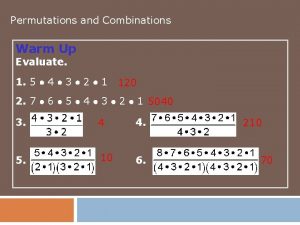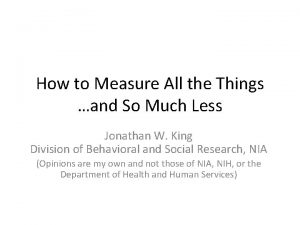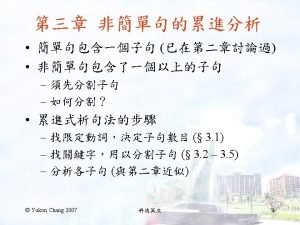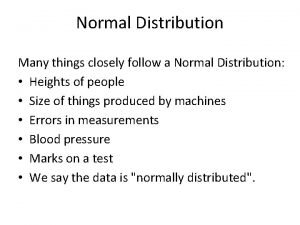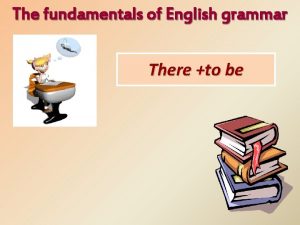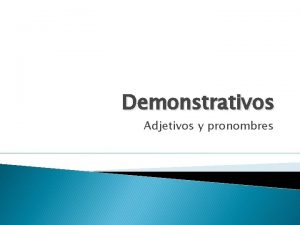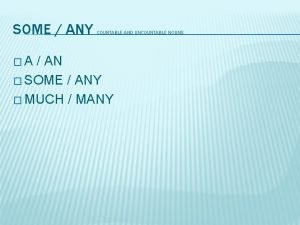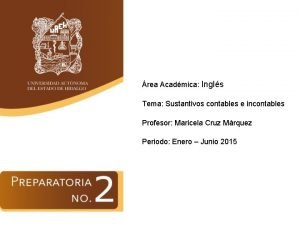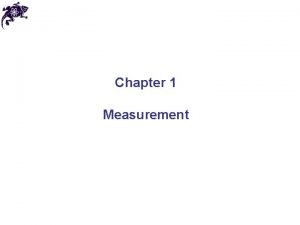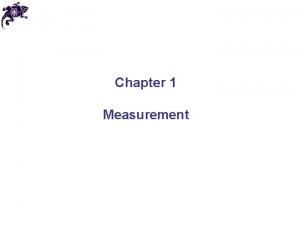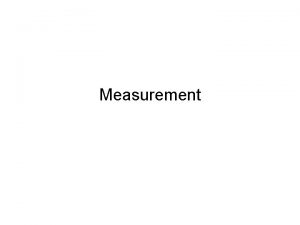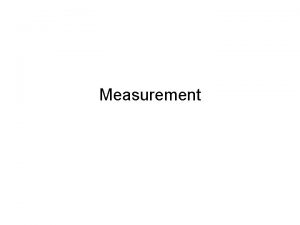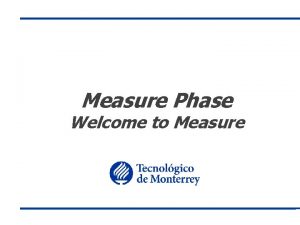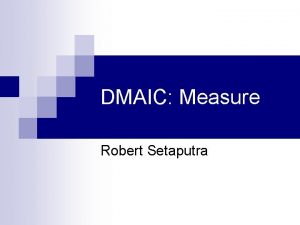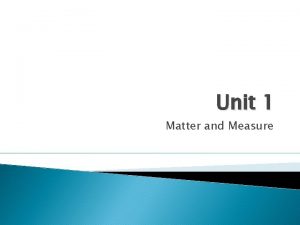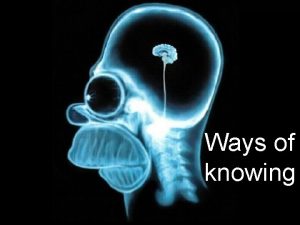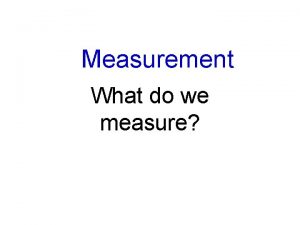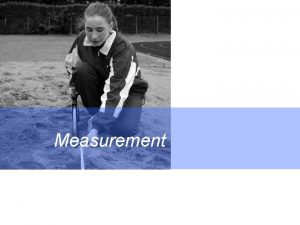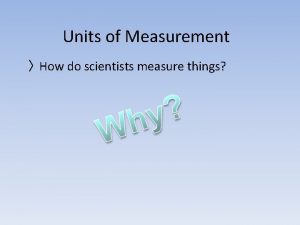Measurement There are many ways to measure things

































- Slides: 33

Measurement There are many ways to measure things and not everyone uses the same units of measure. That’s one reason why scientists developed an International System (SI) for standardizing units of measure. While this system has helped scientists, many people are still unfamiliar with the S. I. system, since the U. S. refuses to go along with the rest of the world. Our goal here is to become familiar with the S. I. system as it is used in the study of chemistry.

Base Units of the S. I. System Quantity n The following units are Time the most basic units of Length the S. I. system. All other units are derived Mass from these basic units. Base Unit second (s) meter (m) kilogram (kg) Temperature kelvin (K) n Notice that the base Amount of unit of mass is the kilogram, not the gram! Substance Electric current mole (mol) ampere (A)

Length n n To measure length, we use the meter A meter is equal to 3. 28 ft. Scientists often need to accurately measure things that are either very small or very big The micrometer at right can measure with an accuracy to 0. 001 mm The “cubit” was not a very precise unit, since it was based on forearm length.

Mass n Mass is defined as the amount of matter. Although the kilogram is the base unit, we normally use grams in lab. n Mass in our class will be measured using a digital balances. They measure to the nearest centigram, or 0. 01 g. n We also have an analytical balance, which measures to 0. 001 g. It is really precise!

Volume Measurements n The units of volume we will use are m. L and L because that is what we measure in the lab. These are a type of “derived” unit, since they are made up of base units. n V = l x w x h or (cm x cm) = cm 3 n 1. 0 cm 3 = 1. 0 m. L n Example: Convert 749 m. L to liters n 749 m. L x 1 L Yeah, this is important! = 0. 749 L 1000 m. L

Can You Read the Volume Correctly? n What is the volume of water in this cylinder? n Read the bottom of the meniscus, estimate to the nearest 0. 1 m. L n 52. 8 m. L (+/- 0. 1 m. L)

Temperature Scales n Most people think that the base temperature units of the S. I. system are degrees Celsius. n While it is true that Celsius is the most commonly used unit, the Celsius scale is actually based on the Kelvin scale. Kelvin is the base unit for temperature. William Thompson, Lord Kelvin • Degrees Kelvin are called Kelvins, K • No degree symbol is used for K • K is also called the “absolute temperature scale” • K = °C + 273

S. I. Prefixes n The best thing about the S. I. system is that it is based on multiples of 10. The English system is based on weird numbers like 16. (Like there are 16 16 ths in an inch…why? !) There are many prefixes used to indicate the size of S. I. units relative to each other. We don’t need to learn them all, but several of them are very common, and must be learned.

S. I. Prefixes To Know Prefix Factor Symbol mega 106 M kilo 103 k deci 10 -1 d centi 10 -2 c milli 10 -3 m micro 10 -6 m nano 10 -9 n

S. I. Conversions n How do we use these prefixes? Why do we need to know this? n Example: Two students were given identical rulers and asked to calculate the area of a piece of notebook paper. One student measured the length of the paper as 28. 0 cm. The other student reported that the width of the paper was 216 mm. Before multiplying these values to find the area, the units of each measurement must be the same. n 216 mm x 1 cm = 10 mm n A = l x w = 28. 0 x 21. 6 = 605 cm 2 n 21. 6 cm Because a mm is 10 times smaller than a centimeter. Notice the conversion factor that was used.

B. S. Rule (This stands for “brilliantly simple”, by the way) n There are many ways to remember how to convert from one unit to another. Many students draw stair steps and know sayings about King Henry. n Try learning the prefixes and using the B. S. Rule. Just draw an arrow between B and S! n B S When going from a big unit to a small unit, move the decimal to the right. n B S When going from small to big units, move the decimal to the left. n Yeah, but how many places do I move it? ?

Number Line If you think of the SI units as being on a number line, you can just hop around. |10 -9 n Smaller |10 -6 µ |10 -3 m |10 -2 |10 -1 |100 |101 |102 |103 c d ↑ da h k base unit |106 M Bigger |109 G

Using the Prefixes n It’s easy to do conversions if you think of the prefixes as being on a number line. n Example: Convert 458 nm to m n Find nm on the number line. Since it is way smaller than the m, the decimal moves to the left nine places. B S 0. 000000458 m or in scientific notation 4. 58 x 10 -7

Dimensional Analysis n n Dimensional analysis is a method of problem solving that uses conversion factors, which are written a fractions. The fractions have numbers as well as units The quantity in the numerator is equivalent to the quantity in the denominator Examples: 10 mm 60 s 1 min § 1 cm 1 min 60 s

How do we do the math? n Most people are pretty comfortable multiplying fractions. n 1 x 5 x 3 = 15 2 3 4 24 we just multiply the numerators together, and then the denominators. Then divide 15 by 24, which is 0. 625 We can also use “Railroad Tracks” to make the calculation look neater: 1 2 | | 5 3 | | 3 4 = 15 24 = 0. 625 Treat units the same way you treat numbers. They get multiplied and divided, too! Example: cm x cm = cm 3 Example: m 3 = m m 2

Dimensional Analysis Example: How many mm are in 147 km? 147 km x 1000 mm = 147, 000 mm 1 1 km 1 m = 1. 47 x 108 mm Step 1: Start with what you are given. Step 2: Multiply by a conversion factor that has the starting units in the denominator, and the unit you want to find in the numerator. (It may take more than one conversion factor to get to where you want to go. ) Step 3: Multiply it out and then write in scientific notation

What about Scientific Notation Math? n When multiplying, add the exponents: 103 m x 104 m = 107 m 2 n When dividing, subtract the exponents 103 m = 10 -1 104 m n OMG what if one of them is like, a negative? 103 m = 10 -4 m 107 3 -(-4) = 7

Using Dimensional Analysis to Solve Problems n If you watched any of the Olympics, you know some amazing athletes competed. Let’s look at some of the new World Records and see if we can convert them to everyday units, using dimensional analysis

Swimming Michael Phelps broke a World Record and won a Gold Medal by swimming the 100 m Butterfly in 50. 58 seconds. n What is this speed in feet per second? How ‘bout in miles per hour? n 100 m x 50. 58 s 3. 28 ft 1 m 6. 48 ft x 1 s 1 mile x 3600 s = 4. 42 mi 5280 ft 1 hr hr = 6. 48 ft s Metric to English conversion factors will be provided if you need them.

Swimming Cesar studies at Auburn University. (Great school. ) n How does Michael’s phenomenal speed compare to another Gold Medalist, Cesar Cielo of Brazil? Cesar swam the 50 m Freestyle in 21. 30 seconds. n 50 m x 21. 30 s 3. 28 ft x 1 mi x 3600 s = 5. 25 mi 1 m 5280 ft 1 hr hr Wow, phaster than Phelps?

Track and Field n Speaking of fast, have you seen this guy run? n Usain Bolt of Jamaica, won a Gold Medal and broke Olympic and World Records with his time on the Men’s 200 meter. n Usain made it look easy as he ran it in 19. 30 s.

Track and Field n Use dimensional analysis to find out Usain’s speed in feet per second, and also in miles per hour. 200 m x 19. 30 s 3. 28 ft 1 m = 40. 0 ft s 40. 0 ft x 3600 s x 1 mi = s 1 hr 5280 ft 27. 3 mi hr

Accuracy vs. Precision n n Accuracy refers to how close a measured value is to an accepted value. In other words, “is it correct? ” The person practicing archery in this photo was not very accurate, only a few of the arrows hit the bull’s eye. They are not very precise either, since the arrows are all over the place. (Random errors. ) This person needs glasses!

Precision n Precision has two general meanings: q q q Precision refers to how close a series of measurements are to one another. In other words, “is it repeatable? ” The word precision is also used to indicate how exact a measurement is. For example, 2. 54 cm is more precise than 2. 5 cm. The target at right shows both accuracy and precision. This archer is accurate and precise!

We need accuracy and precision… World Champion Archer Joo Hyun Jung from Korea says, “You need both precision and accuracy to win the GOLD!”

Significant Figures “Sig Figs” n n If we want to measure things with accuracy and precision, we must consider a topic known as significant figures, a. k. a. significant digits. Significant digits include all known digits plus one estimated digit, for most measuring instruments. Examples: q q A large graduated cylinder can be read to the 0. 1 m. L A buret can be read to the. 01 m. L A digital balance does not have any estimated digits, you just copy all the digits down. Don’t drop final zeroes if they are to the right of the decimal point!

Rules for Sig Figs- gotta know these 5 rules! n Rule Number One: Non Measurement Number of Significant -zero numbers are Digits always significant. 37. 35 m 4 q q Look at these examples: You can see that we are simply counting the number of digits in these measurements. 4563. 9 s 5 198 °C 3

Sig Fig Rules n q Measurement Number of Significant Zeros between non-zero Digits numbers are always significant. 203 g 3 q Look at these examples: Rule Number Two: 1001 km q Again, you can see that we are simply counting all of the digits 1000002 s 4 7

Sig Fig Rules n n Rule Number Three: All final zeros to the right of the decimal point are significant. Measurement Number of Significant Digits 34. 0 m We are used to the idea that 4003. 00 g 2. 0 is the same thing as 2. With measurements, this is not true! The 2. 0 is a more accurate measurement. 1. 000 3 6 4

Sig Figs n n Measurement Number of Significant Digits Rule Number Four: Zeros that act as placeholders are not significant. Convert numbers to scientific 3000 m notation to remove the placeholder zeros. (3 x 103) See how converting to scientific notation lets you see how many digits to count? 1 Only the 3 is significant . 0034 s (3. 4 x 10 -2) 2 . 0430 g (4. 30 x 10 -2) 3 The “leading zeros” are not significant. Remember rule #3 says final zeros to the right of the decimal are significant.

Significant Figures n n Rule Number Five: Counting numbers and defined constants have an infinite number of significant figures. This just means that these numbers do not limit the precision of your calculations. Measurement Number of Significant Digits 29 students Infinitely exact 1000 m. L = 1 L Here, 1000 has an infinite no. of sig figs since this is a definition 2. 54 cm = 1 inch Same reason as above

Calculations Involving Sig. Figs n There are two rules to keep in mind when doing calculations involving significant figures. n When adding or subtracting measurements, your answer must have the same number of digits to the right of the decimal point as the value with the fewest digits to the right of the decimal point. n Example: 28. 0 cm 23. 538 cm 25. 68 cm + 77. 218 cm Line up the decimals! The answer can only go to the tenths place. The answer is 77. 2 cm. (If the sum had been 77. 278 cm, the answer would have rounded up to 77. 3 cm. )

Calculations Involving Sig. Figs. n The second rule is that when multiplying or dividing measurements, your answer must have the same number of significant figures as the measurement with the fewest significant figures. n Example: 3. 20 cm x 3. 65 cm x 2. 05 cm = 23. 944 cm 3 = 23. 9 cm 3 (since you can only have three sig figs, you must round off to the tenth’s place. )
 Insidan region jh
Insidan region jh Many ways to measure
Many ways to measure Gods ways are not our ways
Gods ways are not our ways Convert from degrees to radians 54
Convert from degrees to radians 54 How did historians measure time
How did historians measure time Quantitative emphasis
Quantitative emphasis Gibbons jacobean city comedy download
Gibbons jacobean city comedy download What weather instrument measures air temperature
What weather instrument measures air temperature How to memorize quickly and effectively
How to memorize quickly and effectively There are several ways
There are several ways Computers manipulate data in many ways
Computers manipulate data in many ways Classifying quadrilaterals
Classifying quadrilaterals How is gdp calculated
How is gdp calculated Permutations and combinations
Permutations and combinations Four ways in which ones
Four ways in which ones In many different ways
In many different ways Measure all the things
Measure all the things Uncertainty rounding rules
Uncertainty rounding rules Blue things
Blue things Sensitivity in life processes
Sensitivity in life processes All things denote there is a god
All things denote there is a god There are only two things that are infinite
There are only two things that are infinite At the end of the story, what makes montresor feel sick?
At the end of the story, what makes montresor feel sick? Many things closely follow a normal distribution
Many things closely follow a normal distribution Tema there is there are
Tema there is there are What part of speech is open
What part of speech is open There is there are negative form
There is there are negative form There is there are countable uncountable nouns
There is there are countable uncountable nouns There isn't any burger
There isn't any burger There is there are
There is there are Mathematics john's favourite subject
Mathematics john's favourite subject Adjetivos demonstrativos
Adjetivos demonstrativos A any some
A any some Workbook es contable o incontable
Workbook es contable o incontable

